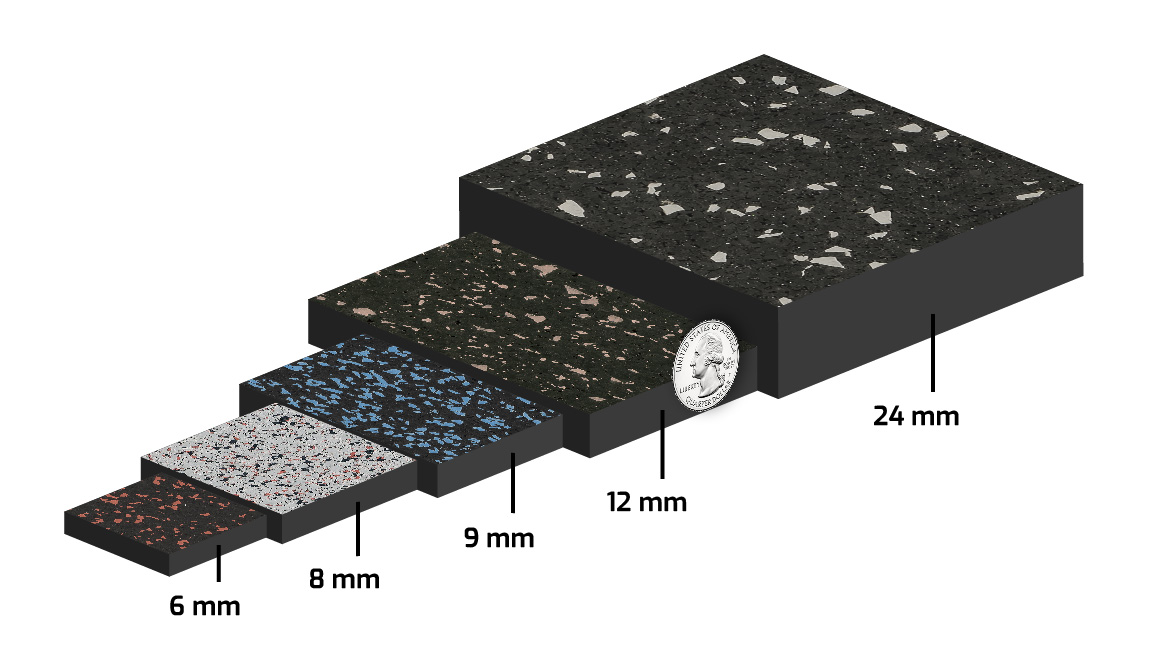Is Your Floor Prepared for Impact?
Rubber Flooring for Weight Rooms: Thickness and Impact Resistance
Choosing a floor for a weight room, especially a free weight area, is intimidating. Why? Because dropping heavy weights on a floor can really do some damage. Think of an olympic lift. Imagine how many 200-pound barbells are bouncing off the floor everyday in a busy commercial gym. That’s a lot of punishment in just one day. Now multiply that stress by 7 days a week. You might realize what a Herculean task your floor has. It must withstand impacts that would send other floors to the scrap heap, and do it on a daily basis.
Nervous yet? You should be. Choosing the right flooring material is critical when it comes to weight lifting areas. There are some real horror stories out there of fitness competitions held on hardwood basketball courts that will make you cringe. In those cases, the floor never recovers, and for that matter, neither does the facility manager. These unfortunate events come from a mismatch of materials.
Hardwoods, as you may have guessed, do not fair well when it comes to resisting the impact of heavy weights. There is really only one material that is up to the task: rubber. Because of its elasticity and resilience, rubber flooring has an extraordinary amount of impact resistance.
Impact resistance is the ability of a floor to absorb the force of heavy weights falling on the surface. Since rubber flooring has excellent impact resistance, it can withstand abuse and recovering unscathed, even in the extreme conditions of a weight room. Rubber flooring is currently the only material that is suitable for this type of activity.
So now that we have narrowed our flooring search to rubber, we can consider the differences in that category. There are several factors that determine how much impact resistance a rubber floor: thickness, density, and design. But for the sake of simplicity, we can focus on thickness.
When it comes to rubber flooring, the saying “less is more” does not apply. In fact, the opposite is true. If you need impact resistance, then “more is more.” Thicker rubber flooring provides more protection and impact resistance. For example, SRH Ultra is a rubber flooring tile that is approximately 1 inch thick (24 mm). Because there is more rubber material in SRH Ultra, it can disperse and absorb more force than SRH Max (8 mm), which is only 8 mm thick. It’s a simple calculation: more material (thickness) means more impact resistance.
To sum everything up, if you want to choose weight room flooring with confidence, first focus on the right material: rubber. Then consider the amount of impact resistance that you need in your space. If olympic lifts and free weight are in the picture, go with a thicker floor, like SRH Ultra. If your space is focused on less demanding activities, thinner rubber floors will do, like SRH Max (8 mm). Those are just the floors at opposite ends of the thickness scale. There are lots of other thicknesses in between to choose from. It’s just a matter of matching how much impact resistance your facility needs to the thickness of the floor you choose. If you need more guidance, contact SRH Sports. We’re here to help.
Share this article.
Sign up for our newsletter.
Want to get the latest news, updates, and offers on sports surfaces? Add your name and e-mail address to our newsletter.

